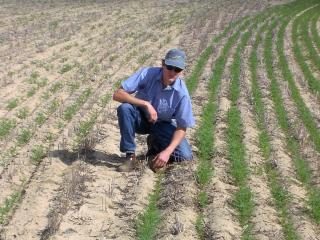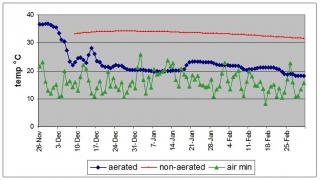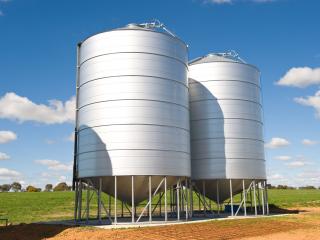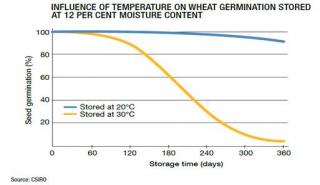What factors may reduce the viability of your retained seed?
Harvest conditions
Wet seed at harvest
When the grain is subjected to wetting at harvest it will absorb moisture and start the chemical process for germination. Often the seed will swell and the skin covering the growing point will split. This seed is referred to as being sprung. Sprouted (or sprung) grain can occur after prolonged periods of wet weather while they are still on the stem before harvest. If the seed dries out before the embryo starts to grow, the seed could still be viable however the seedling vigour is often reduced. For more information refer to Wheat grain quality - falling number and sprouting tolerance and the Barley production - effect of weather damage on quality and varietal purity.

Sprung seed is more susceptible to fungal attack (can become mouldy and infested with alternarias for example) and more are vulnerable to physical damage.
Weather damaged seed deteriorates at a much faster rate that sound seed and should not be stored for more than one season. The seed needs to be stored in cool dry conditions with adequate pest control.
Due to the small seed size of canola (open-pollinate varieties), it should not be retained for seed if there is any weather damage. Seed should never be retained from hybrid canola. For more information refer to the GRDC factsheet Retaining seed.
Dark fungal staining can occur if there is wet, humid weather during grain maturity. It produces a dark brown, black or grey discolouration on any part of the grain and is often associated with shrivelling.
High harvest temperatures and seed moisture
Harvested seed retains its temperature in storage unless it is cooled. Both air and grain are excellent natural insulators and the temperature that grain is loaded in at, is likely to stay relatively constant until grain is loaded out. Thus if the grain is loading in under high temperature conditions, particularly if there is any moisture in the grain, the viability of grain can be significantly affected reasonably quickly.

There is a relationship between storage temperature and moisture on seed germination and the viability of grain deteriorates faster at higher temperatures and moisture content.
Work by CSIRO Stored Grain Laboratory showed that at 30°C storage temperature and 15% moisture content, the viability of wheat had dropped to below 20% after 120 days compared to only 90% when stored at 12% moisture content. At 20°C, the rate of deterioration declined substantially at both moisture contents; the viability of wheat when stored at 15% moisture content was above 90% after 120 days while the drop in viability of wheat stored at 12% moisture content was negligible.
It is recommended that canola is stored below 7% moisture content. Unlike cereals (which typically contain only about 2% oil by weight), the oil fraction of canola (which can be up to 50%) absorbs minimal moisture, meaning a small increase in moisture content can quickly produce self-heating and seed damage.
For more information refer to the GRDC Stored Grain hub
| Maximum temperaure (°C) | Maximum moisture content (%) | |
|---|---|---|
| Cereals | 20 | 12 |
| Canola | 20 | 7.5 |
| Pulses | 20 | 12.5 |


